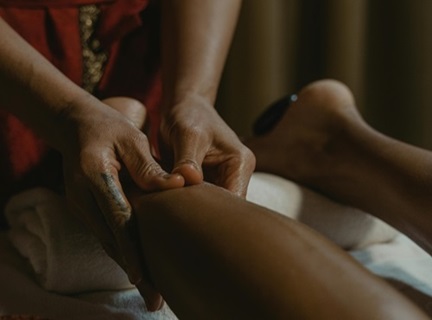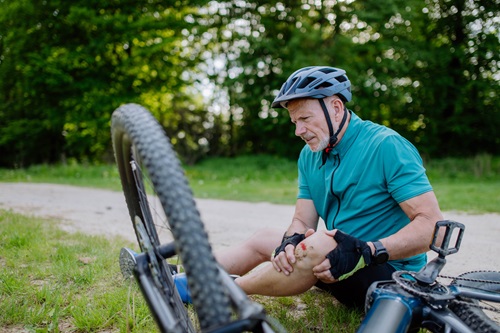The Lowdowns On Rubdowns
Cycling results in a unique set of aches and pains due to the aerodynamic position used to be more efficient, trying to cheat physics whenever possible; this is what you think about when you’re the motor: “I am in good condition, but early season and challenging rides like this can be a wakeup call for the muscles used in cycling.”
Classic symptoms of an early-season ride, combined with the weight of the helmet, made for a tired, stiff neck. Triceps are sore, too. Held in a tuck position, tender triceps and wrists absorb the road chatter and vibrations through the bike. Then, there is the lower back. Last on the list are the glutes and legs, the pistons that transfer the power to the bicycle.
Holding his wrists and hands in a stationary position, the cyclist keeps his fingers flexed and wrists extended; therefore, the extensors and flexors of the arms, wrists and hands are common points of stress on the cyclist’s body.

INJURY ZONES
Holding his wrists and hands in a stationary position, the cyclist keeps his fingers flexed and wrists extended. While maintaining a forward-bent position, his lower back and arm muscles work to support his upper body, remaining in a constant isometric (characterized by equality of measure) state. Due to this unique linear positioning of a forward motion with the body in tight alignment, specific areas of a cyclist’s body are prone to injury.
The extensors and flexors of the arms, wrists and hands are particular problem areas. Ischemia, a temporary blood deficiency, can affect the finger flexors as well as the wrist extensors. Moving down the body, the hip and knee area, including the hamstrings, quadriceps, abductors and gluteals, often experience tightness. The ankles and calves are susceptible to muscle pulls, strains and tears.
Finally, constant strain being placed on the lower back by the cyclist’s forward-bent position can result in injuries to the trunk flexors, lumbars and sciatic nerves. And because cycling relies so heavily on a forward plane of motion, the muscle groups not involved in this movement can easily become tightened and shortened, leading to other problems that massage can address.
The neck can really take a beating having to hold up the head for hours at a time on the bike. Equipment-induced injuries are also prevalent among the cycling population. Even just sitting in the bike saddle for extensive periods of time can cause ischial bursitis, or inflammation of the bursa where the ischeum meets the sacrum.
Furthermore, a saddle position that is too high can result in strains to the Achilles tendon, calves, quads and glutes, while one too far forward can produce anterior knee pain.
Stretching plays an important role in keeping the cyclist’s muscles healthy.
If the wear and tear of sitting on a bicycle were not enough, any cyclist could tell you the toll his body takes when he falls off.
7 COMMON BICYCLING INJURIES
1- Numbness in the hands and fingers:
Among experienced cyclists who already know that they should change their hand positions frequently, numbness is most likely a manifestation of thoracic-outlet syndrome, caused by the rounded-shoulder posture used by many cyclists.

2- Piriformis syndrome:
The proper adjustment of the bicycle is critical to prevent this problem, which severely limits range of motion and stability during cycling.
3- Patellar tendinitis:
This is an overuse syndrome occurring above and below the patella, and frequently involves inflammation or a tear to the quadriceps.
4- Cramping:
Cramps can occur in may muscle below the waist, but are preventable with PNF stretching, proper hydration and close monitoring of calcium level. Treated with ice, compression and myofacial release.
5- Shin splints:
This is an inflammatory overuse condition affecting the anterior tibialis for as much as its entire length. This occurs most often due to incorrect biomechanics during cycling, and responds well to pre- and post-workout stretching. During the acute state, icing is recommended.
Corrective work includes transverse fiber friction where the therapist applies moderate tension and pressure along the body of the muscle during an active movement from full contraction to full extension.
6- Knee injuries:
Cycling is supposed to be knee friendly, but only if the bike is set up properly. For example, if the seat is too far forward or too far back, the direction of force is not directly over the ball of the foot. This can result in anterior and posterior knee pain. Likewise if the pedals and cleats are not properly aligned, knee injuries are likely to occur. Another common cause of knee pain is riding in too low a gear. Even though the pedaling action involves a closed kinetic chain (hence no impact), a gear that is too difficult can place too much stress on the knee joint.
7- Collarbone injury:
It takes about 14 pounds of pressure to break this bone, and it takes about 4 weeks to heal. Scar tissue needs to be broken up by using deep transverse friction. Competitve cyclists, as well as weekend warriors, benefit from the many positive effects of regular massage therapy. Massage keeps these athletes relaxed, pain-free, limber – and on the road.